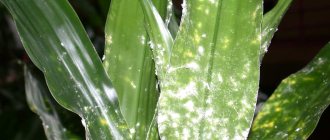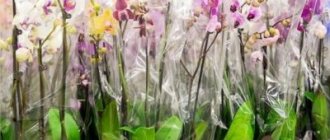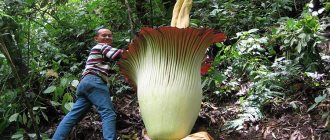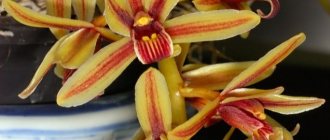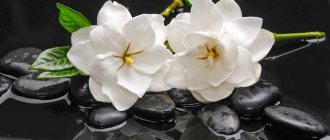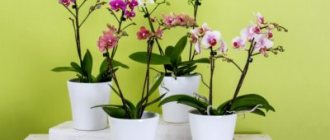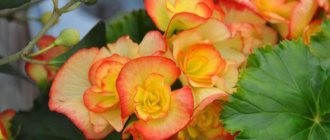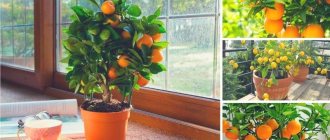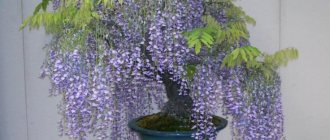International name:
Synonyms:
Characteristics:
| Complexity: |
| Development cycle: |
| Light mode: |
| Watering mode: |
| Temperature: |
| The soil: |
| Key Feature: |
Foliage color
Bud color
Dimensions Flower sizes
Taxonomy:
| Domain: |
| Kingdom: |
| Department: |
| Class: |
| Order: |
| Family: |
| Genus: |
Cymbidium is a special type of Orchid that grows in the tropical regions of India, China, Japan, Southeast Asia and northern Australia. It is one of the most popular Orchids in the world as they are hardy and can withstand cold temperatures and their beautiful colorful blooms last for quite a long time.
Cymbidiums bloom in winter , and ideally each plant produces about 15 buds. For this to happen, you need to take care of sufficient lighting, proper watering, good substrate and moderate fertilization. But in some cases this is not enough - Cymbidiums stop blooming and still look absolutely healthy. Below we will look at several options that will help your Orchids bloom again.
Care
Cymbidium has a large number of subspecies, but caring for all of them is not particularly different from each other. This type of orchid is considered to be the easiest to care for , although it may be difficult for a beginner to grow a healthy plant with little experience in floriculture.
Substrate selection
For cymbidium, you can immediately purchase a ready-made soil mixture at a flower shop.
Typically, the packaging with such a substrate is already marked “For cymbidium and other terrestrial orchids.” More experienced gardeners can prepare the soil mixture themselves. For preparation you need :
- crushed tree bark (it is best to choose coniferous trees);
- sphagnum moss;
- sand;
- charcoal;
- leaf fertilizer;
- perlite
All components are taken in the ratio 3:2:1:1:1:1.
Important! If the temperature in the room with the flower exceeds the required level, then the amount of moss in the soil must be increased several times.
Do not forget that before filling in the soil mixture, you need to place a drainage layer of granite stones, broken shards or expanded clay on the bottom of the planting container. The drainage system is a prerequisite for normal growth and development of epiphytes .
Choosing a pot
Cymbidiums like cramped pots best. The rhizome of the flower should not reach the walls of the container (there should be approximately 2-3 cm to the walls and 5 cm to the bottom). It is best to give preference to transparent planting containers, since these orchids need a lot of light.
You can purchase a ready-made transparent container for orchids with drainage holes already made in a special store.
In principle, you can plant an orchid in a clay pot, but you must understand that the plant will stick its roots to the walls of the container and you will have to break the pot so as not to damage the cymbidium rhizome.
How to water?
- During the warm season (spring and summer), you need to keep the substrate in the container with the orchid moist. Be careful not to let it dry out. For watering, use soft water at room temperature. Excess liquid remaining in the pan after watering must be drained immediately.
- In winter, watering is reduced several times, but they continue to carefully ensure that the soil does not dry out too much. You cannot overdo it with soil moisture, since dampness will lead to the onset of rotting of the rhizome and, accordingly, the death of the plant.
Important! A warm shower has a positive effect on the condition of cymbidium, but after it it is necessary to remove excess moisture from the surface of the plant. This should be done with cotton wool or a soft cloth.
Illumination
Cymbidium belongs to the category of the most light-loving epiphytes . Therefore, it is best to keep it on windows on the south side of the house. In summer, when the sun is most aggressive, you can move the container with the plant to a western or eastern window.
If you decide to leave the flower on the south side, then provide it with shade to avoid burns and overheating.
With a lack of light, the orchid's leaves will drop and the flower stalks will begin to dry out and fall off.
Temperature
Despite such an increased love for light, cymbidium does not like heat too much .
In winter, +10-15 degrees indoors will be enough for him, and in summer 18-25 degrees.
In summer, you can move the orchid to the garden or gazebo outside. But keep in mind that sudden temperature changes between day and night temperatures will negatively affect the condition of the flower.
Air humidity
The air humidity level in a room with cymbidium should always exceed the average (at least 60%). To provide the plant with this level of humidity, you need to use special equipment, for example, air humidifiers. If you do not have the opportunity to purchase such a unit, then simply place the container with the flower on a pallet with wet expanded clay.
In the hot season (spring and summer), you need to spray the orchid at least three times a day. If the humidity in the room is not high enough, then you may soon notice how the tips of the leaves of the cymbidium begin to dry out and the flower stalks begin to fall off.
Overwatering is also fraught with problems with the orchid. It may start to rot. So do not forget to ventilate the room with the flower (but do not leave it in a draft or open sun).
Top dressing
All fertilizers and fertilizing are applied to the soil with watering . The compositions are added to the soil mixture once every two waterings. Usually, preparations that are intended specifically for orchids are used for fertilizer, however, the concentration is reduced by half compared to that recommended on the packaging.
Important! During flowering, cymbidium cannot be fed!
Bloom
The term and time of flowering may vary slightly among different subspecies of cymbidium. The plant can begin flowering at any time of the year , but most often new flower stalks form in the summer, closer to August.
In order for the plant to withstand the weight of the buds, you need to organize a support for it. The flower stalks will begin to open gradually, starting from the bottom of the plant. In total, flowering will take from two months to six months. The number of buds can reach 25-30 pieces.
However, cymbidium may not bloom in its allotted time. If this happens, you need to create special conditions for the plant that will help stimulate the formation of buds and their opening.
How to make it bloom?
It is necessary to create optimal conditions for the formation and opening of flower stalks:
- the air temperature in the room with the plant should reach 22 degrees;
- air humidity must be at least 50%;
- if the plant is hibernating, then you can try to “wake up” it with the help of a temperature difference (just do not allow the temperature to drop to +5 degrees or below);
- the plant should receive enough bright diffused light;
- add fertilizer.
What to do after?
As soon as the flowering of the cymbidium is completely completed, you need to prune the plant and create the conditions necessary for it to rest. If this is not done, then the flower will not be able to gather its strength and will bloom again. And this will deplete his strength and lead to death.
How to care during the dormant period?
Here are a few necessary conditions for normal wintering of cymbidium:
- In winter (during hibernation), the orchid is moved from the street to home (or to a south window if the plant was only indoors).
- Under no circumstances should you keep it near a battery or radiator.
- Watering is reduced to a minimum. A new portion of water is added only when the soil dries out.
- Feeding is reduced to a minimum or not applied at all.
- If you do not have the opportunity to grow cymbidium in the private sector, then it is better to look for other varieties of orchids to grow.
What to do if buds do not appear?
Almost any variety of cymbidium may bloom poorly or not bloom at all. This deviation is especially common in those plants that are kept in a room with temperatures above 22 degrees.
What to do if there is no flowering:
- Try to create conditions in the room with the flower that are as close to natural for it as possible.
- Give the plant more diffused and bright light. If there is not enough daylight, then use fluorescent lamps.
- Create a difference between day and night temperatures (4-5 degrees).
- Bring the humidity level in the room to sufficient (minimum 50-55%).
- Apply appropriate fertilizers.
Diseases and pests
Cymbidium is one of those types of orchids that rarely get sick. Their immunity is quite strong, but this does not mean that they do not get sick at all. The most common pathologies they have are :
- rotting of the rhizome;
- viral mosaic;
- swelling of the leaves;
- falling of flower stalks;
- attack of spider mites, aphids, scale insects.
- Excessive watering and waterlogging lead to putrefactive processes in the substrate and in the rhizome zone . Orchids, in principle, are extremely sensitive to moisture levels; any imbalances towards deficiency or excess result in health problems for them.
- Viral mosaic is a special disease that manifests itself in the form of yellow spots and stripes on the leaves of the plant . The appearance of defects is accompanied by a slowdown in the growth and formation of the flower, distortion of the shape of its flowers, and a change in their color. It is not possible to cure such a plant, so when the first symptoms appear, you need to immediately destroy the orchid (and far from healthy plants).
- When the leaves become swollen, the orchid becomes covered with small growths with a watery membrane around it . Typically, the disease occurs in those plants that are grown at low temperatures and frequently watered. Swelling can easily develop into gray or brown rot, which is not so easy to remove.
- Wilting or underdevelopment of peduncles in cymbidium is an indicator of a lack of phosphorus or calcium supplements . The problem can be solved with the help of appropriate fertilizers.
- As for pests, everything is quite prosaic . Most of all, cymbidium is liked by scale insects, spider mites and aphids. To combat these harmful insects, a soap solution is used to wash the leaves of the plant, as well as appropriate insecticides.
How to transplant: transplant instructions
An orchid can be replanted no more than once every two years. Usually transplantation is carried out for several reasons:
- the substrate has become too dense, depleted and deteriorated;
- the plant began to grow too quickly, which is why many new pseudobulbs appeared on it (the old ones became absolutely useless and only interfere with the normal development of the flower);
- rotting processes were noticed in the orchid.
Before replanting cymbidium, make sure that you have fresh, high-quality substrate and a new planting container ready. The orchid should be placed in the pot so that its growth point (new pseudobulbs) is in the central part of the pot. After transplanting, place the container with the plant in partial shade or in the garden under a tree crown .
Important! During transplantation, old pseudobulbs are removed from the plant.
Watering
In summer, cymbidium needs abundant watering - this is one of the main conditions for its growth.
From lack of watering, the pseudobulbs begin to wrinkle and the flowers begin to fall off. You should water as the soil dries out, but it should never dry out completely.
At the same time, the bay is very dangerous for the plant. Water should not stagnate, otherwise the roots will rot and the plant will die. You can tell that the roots have begun to rot by looking at the leaves—black spots will begin to appear on them.
With the onset of cold weather, the intensity of watering is gradually reduced. By the beginning of winter, the number of waterings should be reduced to 2 times a month.
Reproduction methods
Most often, pseudobulbs or the division method are used to propagate cymbidium. Reproduction by division :
- Immediately after the orchid fades in the spring, you need to replant it.
- As soon as you remove the flower from the substrate, inspect it. If everything is fine with the roots, you need to separate them using a sterile sharp knife.
- Each separated part must contain at least three pseudobulbs and at least one full growing point.
- All separated parts should be planted in a container with fresh soil mixture and watered (but water sparingly for one to two months).
- Once plant growth resumes, switch to standard care regimen.
Reproduction using pseudobulbs:
- For this method, you need to use old pseudobulbs that do not have leaves (or roots).
- Separate them from the mother plant and place them in a homemade greenhouse (under a bag on wet moss). Mist them instead of watering.
- As soon as the pseudobulb has a rhizome (if it was absent initially) or sprouts, you need to transplant them into a planting container and continue to care for them in the usual way for orchids.
Errors during cultivation
In fact, there can be a lot of mistakes. Most of them relate to improper care and maintenance of the plant.
- If the tips of the leaves turn black , this may be a symptom of overfeeding. Since excess useful components accumulate precisely at the ends of the leaf blades, they will first begin to turn black and die with an excess of fertilizers. Only flushing can come to the rescue. Dip the plant substrate into water and wash off excess salts.
- If the ends of the orchid's leaves turn yellow or brown , then this indicates that the air in the room is too dry. It is necessary to increase the humidity level in the room with the plant as soon as possible.
- The appearance of sticky drops on the leaves signals a strong difference in day and night temperatures. Although sometimes this symptom may indicate the presence of harmful insects or a viral infection.
What to do with the peduncle after flowering?
The orchid has faded, but the peduncle is still green. What should I do? Wait to see if it starts to dry on its own. And if this is exactly what happens, let the plant get all the nutrients from the peduncle and only then cut it off.
Has the flower stalk turned completely yellow? You can start removing it. The cut should be made so that a small stump remains at the base, about 1–1.5 cm.
Kinds
Cymbidium has many subspecies that differ in size, color and shape of flowers. The care and maintenance of various types of this orchid is not particularly different from the standard. The most popular varieties of cymbidium :
- dwarf;
- Ivory;
- sword-leaved;
- aloe leaf;
- perceptible;
- low;
- day;
- Tracey;
- giant.
Nothing is impossible for those who are determined to grow a cymbidium orchid at home. Of course, it is better for beginners to gain a little experience in floriculture, since these plants are quite capricious in terms of care and maintenance. But more experienced indoor plant lovers should take the risk. Follow all recommendations and standards of care, and soon your cymbidium will delight you with abundant and bright flowering.
Fertilizer
Feeding is required during the period of active growth - from the first days of spring until the beginning of flowering. It is convenient to fertilize cymbidium during every third watering. After flowering begins, fertilizing should be stopped and resumed only next spring.
We have prepared an entertaining article about what to do if yucca leaves turn yellow.
How to grow mint at home? Our answer is already ready for you.
Hydrogel for indoor plants can be used in different cases. https://sad-doma.net/polezno/gidrogel-dlya-rastenij.html Find out more about this.
